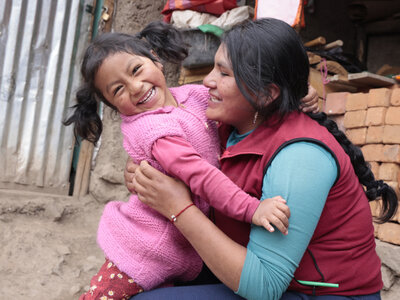Peru
- 31%-plus
- of population at risk of poverty
- 51%-plus
- of Peruvians are food insecure
- 34 million
- population
Peru has achieved remarkable economic growth in the past 20 years, with poverty down by half and chronic malnutrition among children aged under 5 also decreasing.
However, since 2017, the country has faced major challenges. Public expenditure has fallen steadily, monetary poverty has risen, and the frequency and intensity of climate-related emergencies have increased. All this has slowed progress in reducing inequality. In addition, the effects of COVID-19 pandemic threaten progress made in the fight against poverty and malnutrition.
By 2024, 51.7 percent of the population suffered from moderate or severe food insecurity. Malnutrition, including anaemia and obesity and overweight among children and adolescents, is on the rise. Chronic malnutrition is one of the main public health problems among children aged under 5. It affects individuals throughout their lives, limits the development of society and makes it difficult to eradicate poverty.
The World Food Programme provides food assistance and nutrition support, while helping to build resilience and ensure the effectiveness of the supply chain.
What the World Food Programme is doing in Peru
-
Food assistance
-
WFP is working with Peruvian authorities to assist crisis-affected populations in meeting their urgent food, nutrition and associated essential needs, before and during multipronged crises and disasters.
-
Nutrition
-
One of WFP’s main goals is to support national authorities in addressing the triple burden of malnutrition – undernutrition, micronutrient deficiencies and overweight. This includes working to improve the nutritional status of Indigenous Peoples most at risk of malnutrition – through helping improve government capacity in managing health and social government programmes and by promoting rice fortification, for example.
-
Resilience building
-
To address the vulnerability of food systems and ecosystems to crises and the growing threats of climate change, WFP seeks to strengthen the resilience of vulnerable communities, value chain actors and smallholder farmers. We do this by promoting inclusive food systems, ecosystem preservation and the building of adaptive capacities.
-
Supply chain
-
Supply chain is the backbone of WFP operations, keeping us on the frontlines in the fight against hunger. WFP provides logistics support and other services to improve supply chain efficiency and increase preparedness for shocks and stressors.
Peru news releases
Go to pagePartners and donors
Find out more about the state of food security in Peru
Visit the food security analysis pageOperations in Peru
Contacts
Office
Av. José Pardo 831. Pisos 7 y 8 Miraflores - Lima
Peru







